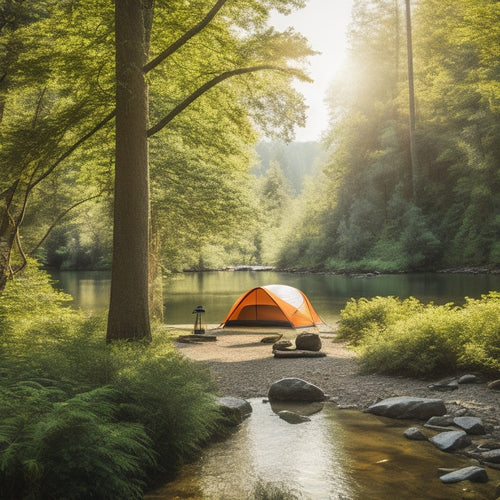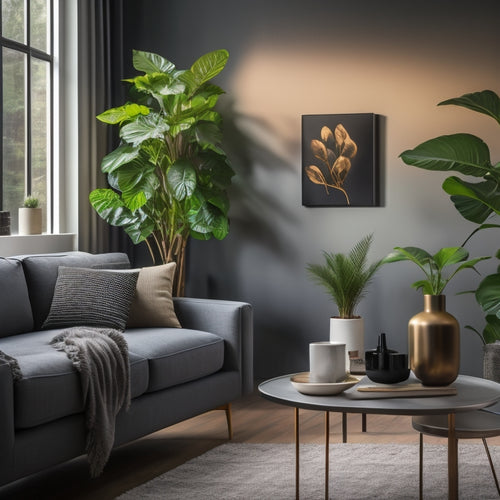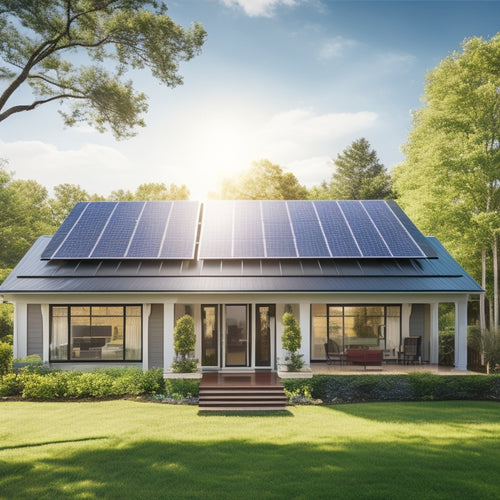
7 Camping Lights Tips for a Brighter Adventure
Share
When choosing camping lights for a brighter excursion, consider factors like energy efficiency, battery life, and lumen count. LED lights save energy, offering longer battery life due to low power consumption, and using up to 90% less energy than traditional incandescent lights. Dimmable mode allows adjusting brightness to conserve energy. Evaluate lumen count to determine light brightness, and choose a light with water resistance, such as an IP67 rating, for durability. Additionally, consider longer battery life, efficient usage habits, and selecting the right lumens for your specific needs. A well-informed decision can illuminate the way to an even brighter outdoor experience.
At a Glance
- LED lights use up to 90% less energy than traditional incandescent lights, enhancing camping light battery life.
- Dimmable mode and low power settings allow for energy conservation and extended battery life in camping lights.
- Evaluating lumen count is crucial for determining light brightness and selecting the right camping lights for specific activities.
- IP67-rated camping lights offer dust and water resistance, ensuring long-term reliability and durability in harsh weather conditions.
- Efficient usage habits, such as turning off lights and using dimmer settings, reduce battery drain and enhance overall camping experience.
LED Lights Save Energy
When you choose LED lights for your camping trip, you can expect longer battery life due to their low power consumption.
This energy efficiency also makes LEDs an environmentally friendly option, as they reduce the need for frequent battery replacements.
Additionally, by utilizing renewable energy sources, such as solar power, you can further minimize your ecological footprint.
Longer Battery Life
Most camping lights available today consume a considerable amount of power, but LED lights are a notable exception. By switching to LED lights, you can greatly extend the battery life of your camping lights. LED lights use up to 90% less energy than traditional incandescent lights, which means you can enjoy more hours of reliable lighting with the same set of batteries.
When combined with lightweight batteries, LED lights become an even more attractive option for campers. These batteries are designed to be compact and energy-efficient, providing you with more power while taking up less space in your backpack.
You can also recharge your batteries on the go using solar chargers, which capture the power of the sun to give you more energy. By choosing LED lights and pairing them with the right batteries and charging systems, you can enjoy longer battery life and more freedom to navigate the great outdoors.
This means you can focus on the things that matter most – enjoying nature, spending time with loved ones, and creating unforgettable memories.
Environmentally Friendly Option
LED lights' energy efficiency not only benefits your camping experience but also the environment. You're minimizing your ecological footprint by choosing a lighting option that consumes considerably less power than traditional incandescent bulbs.
LED lights convert a higher percentage of energy into visible light, resulting in reduced heat dissipation and lower energy consumption.
When shopping for environmentally friendly camping lights, consider solar lanterns that utilize renewable energy from the sun. These lanterns often feature rechargeable batteries, reducing the need for disposable batteries and the waste associated with them.
Look for lanterns made from biodegradable materials or recycled plastics to further minimize your environmental impact.
Some LED lights are designed with recyclable components, making them a more sustainable option at the end of their lifespan. You can also opt for lights with replaceable LED modules, reducing electronic waste and extending the product's lifespan.
Longer Battery Life
When you're camping, extending the life of your light's battery is essential.
Using low power modes, such as red light mode, can help preserve night vision and reduce battery drain.
Developing efficient usage habits, including adjusting brightness settings and utilizing solar-powered lights, can greatly reduce battery drain.
Low Power Modes
To maximize your camping light's battery life, consider utilizing its low power modes. Many modern camping lights come equipped with adjustable brightness settings or specialized low power modes that can greatly extend battery life. These modes often reduce the light's output to a lower intensity, which can be beneficial for tasks that don't require a high level of illumination, such as reading or finding your way to the campsite.
When choosing a low power mode, consider the specific needs of your camping trip. For example, if you're planning a nighttime hike, you may want to opt for a red light mode to preserve your night vision. Red light modes also reduce the disturbance to others in the campsite, enhancing overall camping safety.
Low power modes are essential for power conservation, especially on extended camping trips where access to power sources may be limited. By taking advantage of these modes, you can enjoy a longer battery life and minimize the need for battery replacements, ensuring that you stay safe and connected throughout your journey.
Efficient Usage Habits
Developing efficient usage habits is vital for maximizing your camping light's battery life. To achieve this, you should evaluate your light placement strategies and make adjustments accordingly.
For instance, placing your light at a higher point can help distribute the light more evenly, reducing the need for multiple lights. Additionally, using multi-functional gear can help minimize the number of lights you need to carry, resulting in less battery consumption.
It's also important to turn off your camping light when not in use or when natural light is sufficient. This simple habit can greatly extend the battery life of your light.
Furthermore, using a red light mode or a dimmer setting can help reduce battery consumption without compromising your visibility.
Dimmable Mode Saves Energy
When shopping for camping lights, you'll want to take into account energy-efficient lighting options that help minimize battery drain.
One key feature to look for is a dimmable mode, which allows you to adjust brightness settings to suit your needs. This is especially important for off-grid excursions, where off-grid solar power can be used to charge your batteries, and conserving energy is vital.
Energy Efficient Lighting Options
One of the most effective ways to minimize your carbon footprint while camping is to opt for energy-efficient lighting options.
Solar lanterns are a great choice, as they capture the power of the sun to charge during the day, providing a reliable source of light at night. Rechargeable batteries and portable chargers can also be used to power your camping lights, reducing the need for disposable batteries and minimizing waste.
When selecting energy-efficient camping lights, look for compact designs that are multi-functional and offer adjustable light settings.
Consider the color temperature of the light, as cooler temperatures can be more energizing, while warmer temperatures can promote relaxation. Light diffusion is also important, as it can help to reduce glare and improve visibility.
By choosing the right power sources and lighting options, you can reduce your energy consumption and stay safe while camping.
Utilizing these camping hacks can help you enjoy the great outdoors while minimizing your impact on the environment and ensuring your outdoor safety.
Adjustable Brightness Settings
Energy-efficient lighting options can take your camping experience to the next level, and selecting the right lighting with adjustable brightness settings can further enhance this experience.
Adjustable brightness settings, also known as dimmable mode, allow you to customize the light output to suit your needs. This feature not only saves energy but also extends the battery life of your camping lights.
When shopping for camping lights, look for models with adjustable brightness settings that cater to your user preferences. Some models come with preset brightness levels, while others offer continuous brightness control. The latter option allows you to fine-tune the light output to your desired level. This feature is particularly useful when you need a low light setting for reading or finding your way in the dark.
Brightness control is essential for a comfortable camping experience. It enables you to adjust the light output according to your activities and the surrounding environment.
Lumen Count Matters
When choosing a camping light, you'll need to evaluate the right lumen count for your needs. This requires comparing the lumen output of different lights to guarantee you find one that's bright enough for your campsite.
Understanding how different lumen counts affect the lighting performance will help you make an informed decision.
Before making a final decision, it's also crucial to reflect on the overall battery life and health, which can be improved by following battery maintenance tips, such as maintaining ambient temperature and proper ventilation control for ideal battery performance.
Choosing the Right Lumens
During your search for the perfect camping lights, you'll inevitably come across the term "lumens" – a unit of measurement that quantifies the amount of light emitted by a source. Understanding lumens is essential in choosing the right camping lights for your needs.
There are different lumen types, including initial lumens, mean lumens, and lumens per watt. Initial lumens refer to the light's brightness when it's first turned on, while mean lumens represent the average brightness over the light's lifespan.
When selecting a camping light, consider the brightness levels you need. Task lighting, such as cooking or reading, requires lower lumens (10-100), while ambient lighting, like illuminating a campsite, requires higher lumens (100-500).
If you plan to use your light for long-distance activities, like hiking or searching, you'll need even higher lumens (500-1000). Consider your specific needs and the environment you'll be in to determine the right lumen count for your camping lights.
Lumen Count Comparison
To effectively compare lumen counts, you'll want to evaluate the specific tasks you'll be performing and the environment you'll be in. Different lumen measurements are best suited for various activities, such as reading, cooking, or traveling through the woods.
For example, a lumen count of 50-100 is sufficient for reading and close-up tasks, while 200-300 lumens are better suited for cooking and task lighting.
When comparing lumen counts, consider the brightness levels required for your specific needs. A higher lumen measurement doesn't always mean a better light. It's crucial to balance brightness with battery life and overall usability.
For instance, a headlamp with adjustable brightness modes can help conserve battery life and provide the right amount of light for the task at hand.
When evaluating camping lights, look for a lumen measurement that aligns with your specific needs. Compare the lumen count to the manufacturer's recommended uses and consider the light's overall performance, including beam distance and color temperature.
Water Resistance Beats Rivals
When it comes to water resistance in camping lights, you'll often come across the IP67 rating.
This rating indicates the light's ability to withstand dust and water ingress, with the first digit (6) representing protection against dust and the second digit (7) representing protection against temporary immersion in water up to 1 meter.
Understanding the IP67 rating will help you choose a camping light that can withstand the elements and keep you safe.
IP67 Rating Explained
What sets IP67-rated camping lights apart from their rivals regarding water resistance? To answer this, you need to understand the IP67 certification and its implications on waterproof standards.
IP67 is a rating that signifies a product's ability to withstand solid particles (dust) and water ingress. The '6' in IP67 represents the product's dust-tight rating, while the '7' indicates its ability to withstand being submerged in water up to 1 meter for 30 minutes.
For outdoor enthusiasts, IP67 certification is a vital factor to take into account when selecting camping gear. It guarantees that your camping lights can withstand harsh weather conditions, such as heavy rain or snow.
Additionally, IP67-rated camping lights are designed to provide long-term reliability and durability, making them an ideal choice for extended outdoor excursions. By choosing IP67-rated camping lights, you can rest easy that your gear will perform at its best even in the most challenging outdoor conditions.
This level of outdoor durability and water resistance is unmatched by many rival products, making IP67-rated camping lights the top choice for campers and outdoor enthusiasts.
Frequently Asked Questions
Can I Use Camping Lights for Indoor Purposes?
You can repurpose camping lights for indoor lighting, leveraging their versatility in alternative settings. Many models offer adjustable brightness and compact designs, making them suitable for indoor use, such as in attics, basements or garages.
Do Camping Lights Attract Insects at Night?
Imagine walking through a warm summer night, surrounded by a swarm of insects. You're likely to attract them with your lights. Opt for LED options with a yellow or red hue, or use an insect repellent nearby.
How Do I Store Camping Lights for Long Periods?
When storing lights for long periods, you'll want to prioritize light maintenance and research storage solutions. Clean lights thoroughly, remove batteries, and use protective cases or bags to prevent damage and corrosion, ensuring they're ready for your next journey.
Can I Use Rechargeable Batteries in Camping Lights?
You can use rechargeable batteries in camping lights, opting for nickel-metal hydride or lithium-ion types for best performance. These batteries maintain camping light brightness and can be reused multiple times, offering cost-effective freedom.
Are Camping Lights Suitable for Extreme Cold Weather?
You'll find that many modern camping lights are designed to withstand extreme cold weather. LED performance remains relatively stable in low temperatures, but battery life may decrease, so choose lights with cold-weather optimized batteries.
Explore More
You've spent all day hiking and setting up camp, only to find yourself stumbling around in the dark - the ultimate camping irony. It doesn't have to be that way. By choosing LED lights that save energy, last longer, and offer dimmable modes, you'll be illuminating your path in no time. Just remember, a higher lumen count and water-resistant design will make all the difference in a brighter, stress-free journey.
Related Posts
-

Top Eco-Friendly Camping Equipment for a Sustainable Adventure
When you're camping with the planet in mind, opt for eco-friendly gear like tents made from recycled materials and bi...
-

Smart Home Thermostats to Revolutionize Your Space
Smart home thermostats revolutionize your space by providing precise temperature control and optimizing energy saving...
-

Home Solar Installation Cost
You're considering installing solar panels on your home, and the upfront cost is likely the biggest hurdle standing i...


